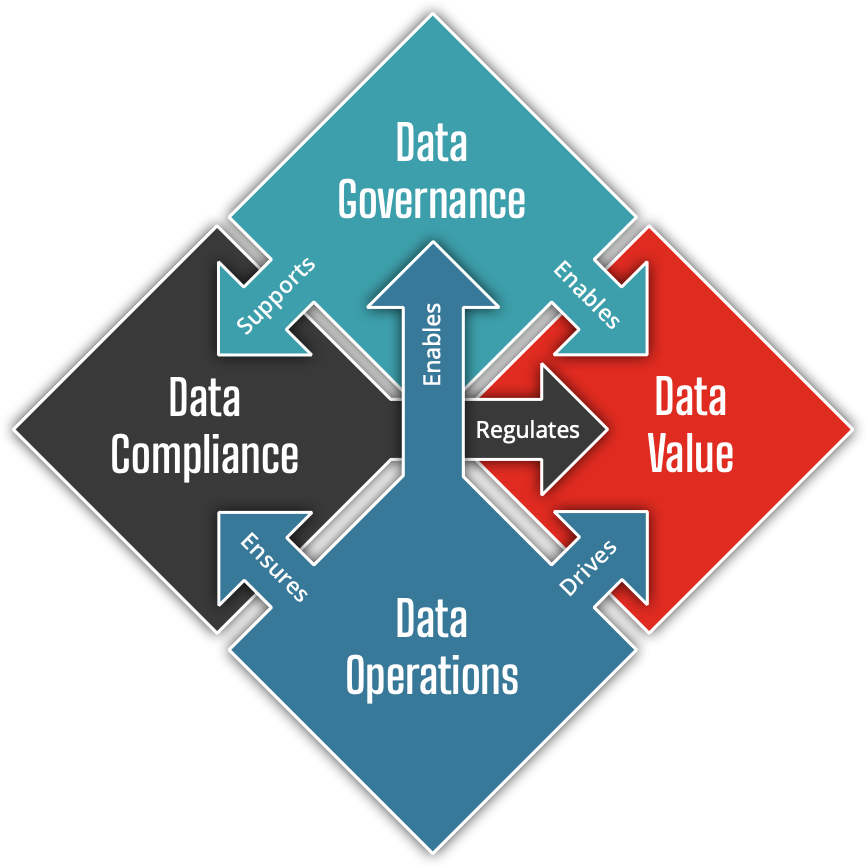A Data Strategy & How To Build One Part I
A deeper look into main pillars of a data strategy
Although everyone is aware of how important data is for accelerating business growth, many companies still have trouble utilizing it to its full potential due to the volume and difficulties involved, specifically the inability to gather, manage, organize, and analyze numerous data sources under one roof and then put the results to use.
By employing their data to create an artificial intelligence solution, businesses today want to boost their profitability. However, they frequently fail to accomplish their goals because they do not have ideal data strategies in place. The Value, Collection, Architecture and Governance pillars form the foundation of the data strategy. I have observed typical errors made by businesses attempting to develop data strategies. I want to outline recommended practices for developing a data strategy. A clear data strategy is the solution if you want your data efforts to genuinely pay off. But what exactly is a data strategy, and how do you even begin to create one? Everything you ought to know is covered in our detailed guide.

What is a data strategy?
A data strategy is a strategy that tries to enhance every aspect of how your company gathers, organizes, saves, shares, and uses data. It is formally described as a "central, integrated concept that articulates how data will enable and inspire business strategy" by the MIT CISR Data Board. In the end, data strategies make sure that all of a company's data resources are set up in a way that makes it simple and effective for them to be transferred, shared, and utilized.
Data is no longer just a by-product of running your business – it’s a vital asset that can drive decision-making and processing (and revenue). To that end, a data strategy helps to ensure a business’s data is treated as an asset by managing and using the data, defining goals and objectives for effective and efficient data usage across departments and projects and ensuring it is privacy compliant.
This provides common objectives, methods, practices and processes to manipulate, manage and share data throughout an organization.

Why do you need a data strategy?
There are many reasons why firms need to develop data strategies, but they all boil down to the same thing: data is a crucial corporate asset and should be handled as such.
On a business level, data strategies can:
Describe how the company can use its data to achieve its aims.
Identify the adjustments that must be made by a company to maximize the value of its data and develop a workable roadmap for the company to follow about milestones, priorities, and upcoming data management strategies.
Define the financial rewards and implications of data activities, and present takeaways that may be leveraged to boost revenue and monetize data.
But there are other, wider benefits too:

Data strategies unlock the value of data
The new money in business is data. Organizational leaders are aware of this, yet maximizing its potential can be difficult for them since they may not know how to do it. This is where a data strategy may make a real difference by giving staff members instructions on how to use, manage, and share data.
Data strategies effectively handle the vast volume of data available to businesses
90% of the data in the world has been produced in the last two years. A comprehensive data strategy is becoming necessary as organizing, storing, and using the growing amount of data becomes more difficult.
Data strategies solve company-wide data challenges
When a business is dealing with data problems, its initial inclination is frequently to look for a quick fix. However, this point-based strategy may be ineffective for dealing with problems that persist over time or cross-departmental or project boundaries.
Implementing a company-wide solution is advantageous since data access and usage are requirements that affect the entire organization. By allowing separate departments to cooperate rather than compete with one another, this type of plan ensures that data management is improved throughout the entire organization.
Data strategies prevent data silos
Without a data strategy, several departments are likely to store, manage, and address data-related problems independently. That could result in challenges with data access and transfer for the entire organization as various departments might transfer raw data into any format they have access to. This strategy potentially exacerbates the development of data silos and wastes resources.
However, with a data management plan, each department will adhere to the same rules that specify the format that data should be in as well as the sharing and accessing options. This avoids the development of data silos, facilitates the establishment of consistent data profiles, and makes it simple and effective for many departments and individuals to access the data.
The 4 Components of a Data Strategy
Value
The purpose of the value component in a data strategy is to identify data and understand its meaning regardless of its structure, origin or location.
If the data is structured or unstructured, without a name, defined format and value representation, manipulating and processing it just isn’t feasible. Instead, establishing consistent data element naming and value conventions is key to data usage and sharing.
Just as vital is having a means of referencing and accessing the metadata associated with datasets, i.e. their definition, origin, location and domain values. Successful data usage depends on the existence of such metadata to help retrieve specific data elements and overall help to identify and diversify different datasets.
Without a means of referencing and accessing metadata, a business is unlikely to know the location and meaning of all of its data, as well as its numerous sources. In addition, failure to incorporate data identification details would result in new data inventory and analysis efforts each time new data needed to be included in processing or analysis activities.
Ultimately, failures to identify data and metadata would lead to companies ignoring their most prized data assets through the inability to know that they even exist. If the business’s data is truly an asset a data strategy must include an identification component.
Collection
In a data strategy, this component places data in a structure and location that supports easy shared access and processing.
A fundamental feature of all corporate IT stacks is data storage. Businesses will have mechanisms in place for determining and managing the storage requirements of their application systems, but these techniques frequently only take data production into account and do not account for sharing and consumption requirements.
When there needs to be a mechanism to effectively manage the storage needed to share and transport data between systems, such an approach falls short. Due to the transactional nature of visible data transmission, a gap frequently develops. Because transactional information is frequently only sent and exchanged among applications to complete particular business processes, bulk data sharing is frequently misunderstood or mistaken for an infrequent event.
However, with the growing volume of data available to businesses and the rise in big data, bulk sharing is now becoming increasingly common across businesses and industries.

As a majority of the shared content can be categorized as either internally created data, such as customer details or purchase history, and externally created data, such as cloud application data, third-party data or syndicated content, lack of a centrally managed data sharing process will force systems to individually manage the space created – meaning that fragmented copies of the source data will emerge.
A good data strategy will ensure that data created is efficiently stored, and available for future access, without needing individuals to create their copies. CDPs in particular can help with this, as all 1st, 2nd and 3rd-party data is stored in the platform (including private information such as customer names, postal addresses, emails, and phone numbers). Plus, CDPs can connect to advertising tools found in tech stacks, which allows them to store DMP-type information like cookie IDs with audience tags.
Architecture
The core of a strong architecture in a data strategy is how data may be reused and shared, as well as how to provide rules, access, and guidelines.
When data is exchanged, the application developer, not the data consumer, typically packages the data. This strategy may have been effective in the past when fewer systems and teams required access, but it is no longer as effective in the modern world where numerous systems, teams, and applications depend on data from various sources to support business activities.
Packaging and sharing data from a single source developer and then training individuals in learning the idiosyncrasies of a multitude of different source application systems so that they can access and use the data is a drain on business resources and time.
Because sharing data is now a critical business need as data has to support operational and analytical purposes, the method for data packaging and sharing is no longer a one-off: it must be consistent across applications.

For a company’s data to truly become an asset, a data strategy should address data provisioning as a standard business procedure and present guidelines dictating how the data must be packaged and prepared for sharing. To move and combine data that resides in disparate systems to provide a unified and consistent data view.
At the time of creation, data is a raw commodity that has not been prepared, transformed or corrected to make it ready for use. So a data strategy process is the key component that addresses the activities required to transform data from a “raw material” into a usable asset.
Similarly, data produced by an application is also a raw material. The majority of organizations get their data from both internal and external sources. While external data may be supplied by cloud apps or data providers, internal data may be produced by dozens of application systems. Even if the data is rich in information, it won't have been packed in a way that will allow it to interface with a variety of sources that are used by different businesses.
Therefore, several actions must be taken to rectify, format, and change the data to make it usable. The process produces several related data sets that can be combined or integrated by data consumers depending on their needs (for example, analytics, data sharing, processing, or transactions).
Governance
The final component of a data strategy is governing the data by establishing, managing and communicating information policies for effective data usage.
The biggest challenge with data governance is adoption. Many data governance initiatives begin by addressing specific issues, like data accuracy or terminology, and are then confined to either specific organizations or projects.
However, the reason for establishing a governance framework is to ensure that the rules, details usage, manipulation and management of the data are known by all other data constituents who would have access to, or the need to use, the data.
Put simply, the role governance plays within a data strategy is to ensure that data is managed consistently throughout an organization. Data governance shouldn’t serve to limit data access or insert an unusable level of gatekeeping that interferes with data usage: data governance’s premise is simply to ensure that data is easy to access, use and share throughout the organization.

In this first part, we talk about the 4 core components of a strong data strategy, you have certainly remarked that I used to recommend any platform in this article, the next part will be more practical and focus on different steps to build a data strategy using a platform.
Conclusion
Data is the heart of digital transformation and offers incredible opportunities for organizations to accelerate the most strategic business outcomes, such as:
increasing revenue by understanding customer preferences and offering personalized experiences,
enhancing workforce productivity by making data-derived insights easily accessible to each worker to foster data-informed decision-making.
Primarily, organizations need to be guided by a robust data strategy. This in turn will enable them to get value from data and turn it into a competitive advantage. The bottom line is that data-driven companies innovate faster. First, they can continuously optimize their operational efficiencies regardless of the size and complexity of their organizations, and as a result, they keep costs down. Second, they can adapt quickly as market conditions change.
Here are four potential ways to drive new value using data:
Applications: Accelerated product development and shorter time to market
Analytics: Greater organizational and operational efficiency, agility, and pace to execute innovative programs.
Visualizations: Increased productivity by using the right intuitive tools to allow doing advanced analytics and AI.
Predictions: Creating differentiated solutions driven by Data and AI
We will talk about it more in the article, so read me soon!
Feedback is welcomed.
And as always, use AI responsibly.
If you like this content please like it ten times, share the best you can and leave a comment or feedback.
@#PeaceAndLove

